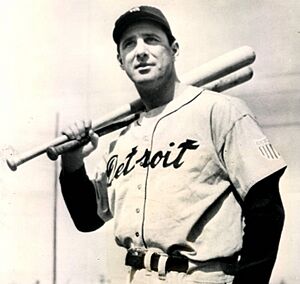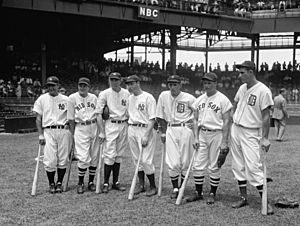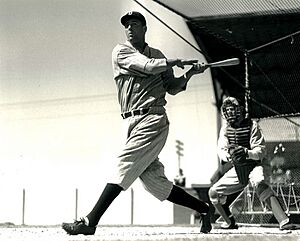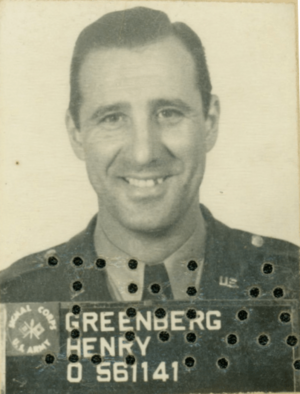Hank Greenberg facts for kids
Quick facts for kids Hank Greenberg |
|||||||||||||||||||
|---|---|---|---|---|---|---|---|---|---|---|---|---|---|---|---|---|---|---|---|

Greenberg in 1946
|
|||||||||||||||||||
| First baseman / Left fielder | |||||||||||||||||||
| Born: January 1, 1911 Manhattan, New York, U.S. |
|||||||||||||||||||
| Died: September 4, 1986 (aged 75) Beverly Hills, California, U.S. |
|||||||||||||||||||
|
|||||||||||||||||||
| debut | |||||||||||||||||||
| September 14, 1930, for the Detroit Tigers | |||||||||||||||||||
| Last appearance | |||||||||||||||||||
| September 18, 1947, for the Pittsburgh Pirates | |||||||||||||||||||
| MLB statistics | |||||||||||||||||||
| Batting average | .313 | ||||||||||||||||||
| Home runs | 331 | ||||||||||||||||||
| Runs batted in | 1,276 | ||||||||||||||||||
| Teams | |||||||||||||||||||
|
|||||||||||||||||||
| Career highlights and awards | |||||||||||||||||||
|
|||||||||||||||||||
| Induction | 1956 | ||||||||||||||||||
| Vote | 85.0% (ninth ballot) | ||||||||||||||||||
|
|||||||||||||||||||
Henry Benjamin Greenberg (born January 1, 1911 – died September 4, 1986) was a famous American professional baseball player. People called him "Hammerin' Hank" because he hit the ball so hard! He played mostly for the Detroit Tigers as a first baseman in the 1930s and 1940s.
Hank Greenberg was a true baseball legend. He is in the Baseball Hall of Fame. He also won the Most Valuable Player (MVP) Award twice. He was known as one of the best power hitters of his time. A "slugger" is a player who hits the ball with great power, often for home runs.
Greenberg played 12 of his 13 major league seasons with the Detroit Tigers. He was an All-Star four times. He was named the American League (AL) Most Valuable Player in 1935 and 1940. He hit over .300 in eight seasons. He also helped the Tigers win two World Series championships in 1935 and 1945.
He led the AL in home runs four times. In 1938, he hit 58 home runs. This was almost as many as Babe Ruth's record. He was the first player to hit 25 or more home runs in both the American and National Leagues. He also holds the AL record for most runs batted in (RBIs) in a single season by a right-handed batter.
When the United States joined World War II, Greenberg was the first major league player to join the military. He served for 47 months, which was more than any other player. This time away from baseball was during his best playing years. His career stats would have been even higher if he hadn't served. After the war, in 1947, he played his final season for the Pittsburgh Pirates. After retiring, Greenberg continued to work in baseball as an executive.
Greenberg was the first Jewish superstar in American team sports. He made a big decision in 1934 during a close pennant race. He chose not to play on Yom Kippur, a very important Jewish holiday. He spent the day at his synagogue instead. He also faced unfair treatment because he was Jewish. But he was one of the few players who publicly welcomed Jackie Robinson to the major leagues in 1947. Jackie Robinson was the first African-American player in MLB.
Contents
Early Life and Baseball Start
Hank Greenberg was born on January 1, 1911, in Greenwich Village, New York City. His parents were Jewish immigrants from Romania. He was the third of four children. His family owned a successful business.
They later moved to the Bronx. Hank went to James Monroe High School. He was a great athlete in many sports. His basketball coach even gave him the nickname "Bruggy." Baseball was his favorite sport, and he loved playing first base. He was also good at basketball, soccer, and track and field.
In 1929, when he was 18, the New York Yankees wanted to sign him. But the Yankees already had Lou Gehrig at first base. So, Greenberg decided to go to New York University on a scholarship. He also tried out for the New York Giants. But their manager, John McGraw, wasn't impressed. After his first year of college, Greenberg signed with the Detroit Tigers.
Professional Baseball Career
Minor League Journey
Greenberg played in the minor leagues for three years. In 1930, he played for the Hartford Senators and the Raleigh Capitals. He hit .314 with 19 home runs that year. In 1931, he played for the Evansville Hubs. He hit .318 with 15 home runs.
In 1932, he played for the Beaumont Exporters. He hit 39 home runs and had 131 RBIs. He won the Most Valuable Player award for the league. He also helped Beaumont win the Texas League title.
Major League Debut
Greenberg made his major league debut on September 14, 1930. He was a pinch hitter against the New York Yankees. He was only 19 years old, making him the youngest player in the majors that year. He didn't play again in the majors for three more years.
In 1933, he rejoined the Tigers. He hit .301 with 87 RBIs.
Becoming a Star Player
In 1934, his second full season, Greenberg hit .339. He helped the Tigers reach their first World Series in 25 years. He led the league with 63 doubles. He was also third in the AL in RBIs with 139.

Late in the 1934 season, Greenberg faced a tough choice. He announced he would not play on September 10 (Rosh Hashanah) or September 19 (Yom Kippur). These are important Jewish holidays. Some fans were upset, saying the Tigers hadn't won a pennant since 1909.
Greenberg thought hard about his decision. He talked to his rabbi and his father. He decided to play on Rosh Hashanah. He hit two home runs in a 2–1 Tigers win that day. The next day, the Detroit Free Press wished readers "Happy New Year" in Hebrew.
However, he stuck to his decision not to play on Yom Kippur. The Tigers lost 5–2 to the New York Yankees without him. The team went on to lose the 1934 World Series to the St. Louis Cardinals.
In 1935, Greenberg had an amazing season. He led the league in RBIs (168) and home runs (36). He was voted the Most Valuable Player in the American League. He led the Tigers to another pennant. But he hurt his wrist in Game 2 of the 1935 World Series. The Tigers still won their first World Series title without him.
In 1936, Greenberg re-injured his wrist. He played only 12 games that season.
In 1937, he came back strong. He drove in 184 runs, which is the third-highest all-time. He hit 40 home runs and batted .337. He was voted to the AL All-Star team.

Greenberg was a powerful home run hitter. In 1938, he hit 58 home runs. This was close to Babe Ruth's record. He set a major league record with 11 games where he hit multiple home runs. He also hit 39 home runs in his home park, Briggs Stadium, which is still a record.
In 1939, Greenberg was an AL All-Star again. He finished second in the AL with 33 home runs. After this season, the Tigers asked him to move from first base to left field. This was to make room for another great hitter, Rudy York. Greenberg agreed but asked for a bonus if he learned the new position well. He earned that bonus!
In 1940, Greenberg played left field. He was an All-Star for the fourth time. He led the AL in home runs (41) and RBIs (150). He also led the Tigers to the AL pennant. He won his second AL MVP award. He was the first player to win an MVP award at two different positions. However, the Tigers lost the 1940 World Series to the Cincinnati Reds.
Serving in World War II
On October 16, 1940, Hank Greenberg was the first American League player to sign up for the draft. This was before the U.S. officially joined the war. He was first classified as "4F" because of "flat feet." But he asked to be reexamined. He wanted to serve his country.
On May 7, 1941, he joined the U.S. Army. His baseball salary of $55,000 a year dropped to $21 a month. In December 1941, he was honorably discharged. This was just two days before Japan attacked Pearl Harbor.
After the attack, Greenberg re-enlisted on February 1, 1942. He volunteered for the Army Air Forces. He became the first major league player to do so. He became a first lieutenant and later a captain. He served in the China-Burma-India Theater. He helped find locations for B-29 bomber bases.
Greenberg served for 47 months in the military. This was longer than any other major league player. He missed several years of his baseball career during this time.
Return to Baseball
Greenberg was discharged from the Army on June 14, 1945. He was the first major league player to return to baseball after the war. In his first game back on July 1, he hit a home run!
In 1945, Greenberg played left field in 72 games and batted .311. He helped the Tigers win the American League pennant. He hit a dramatic grand slam home run on the last day of the season. This win sent the Tigers to the 1945 World Series. They beat the Cubs in seven games. Greenberg hit two of the three home runs in that World Series.
In 1946, he returned to playing first base. He led the AL in home runs (44) and RBIs (127) for the fourth time.
In 1947, Greenberg had a disagreement about his salary with the Tigers. He decided to retire rather than play for less money. So, Detroit sold his contract to the Pittsburgh Pirates. To convince him to play, the Pirates offered him a record $100,000 salary. This made him the first baseball player to earn that much in pure salary. The Pirates even made their left field shorter and called it "Greenberg Gardens" to help him hit more home runs.
Greenberg played first base for the Pirates in 1947. This was the same year Jackie Robinson joined the Major Leagues. Robinson was the first African-American player. Greenberg had faced unfair treatment himself because he was Jewish. So, he understood what Robinson was going through. He was one of the few players who publicly welcomed Robinson. During a game, Greenberg told Robinson, "Stick in there. You’re doing fine. Keep your chin up." Robinson later said, "Class tells. It sticks out all over Mr. Greenberg."
In his final season of 1947, Greenberg was still a good player. He tied for the league lead in walks with 104. He hit 25 home runs. He was the first player to hit 25 or more home runs in both the American and National Leagues. Even though he was still productive, Greenberg decided to retire. He took a job in the front office with the Cleveland Indians.
Player Profile
Career Highlights
Many people believe that if Hank Greenberg hadn't served in World War II, his career numbers would be much higher. He missed almost four full seasons during his prime playing years.
Greenberg played nine full seasons. He hit 331 home runs and had 1,276 RBIs in 1,394 games. He was also a great hitter for average, with a lifetime batting average of .313. He was named to the All-Star Team four times. He won the AL Most Valuable Player Award twice.
When he started, Greenberg was a bit clumsy as a fielder. But he worked very hard to become excellent at first base. He had a higher-than-average fielding percentage. In 1940, he moved to left field. He practiced tirelessly and improved greatly, making zero errors in the outfield in 1945.
| Category | G | AB | R | H | 2B | 3B | HR | RBI | SB | CS | BB | SO | BA | OBP | SLG | OPS | PO | A | E | DP | FLD% | Ref. |
|---|---|---|---|---|---|---|---|---|---|---|---|---|---|---|---|---|---|---|---|---|---|---|
| Total | 1,394 | 5,193 | 1,046 | 1,628 | 379 | 71 | 331 | 1,276 | 58 | 30 | 852 | 844 | .313 | .412 | .605 | 1.017 | 11,023 | 741 | 122 | 974 | .990 |
Facing Challenges as a Jewish Player
During his career, Greenberg faced unfair treatment because he was Jewish. Some players and fans would shout mean things at him. Greenberg sometimes fought back against these attacks. He once challenged the whole Yankees team to find out who was making the comments.
In the 1935 World Series, an umpire had to warn three Chicago Cubs players. They were yelling mean things at Greenberg. The umpire even removed them from the bench.
Greenberg initially didn't like being called a "Jewish ballplayer." He just wanted to be known as a great player. But later, he accepted his role. He said he wanted to be remembered as a great Jewish ballplayer.
At 6 feet 4 inches tall, he showed that Jewish people could be strong athletes. His decision not to play on Yom Kippur was very important. It made him a hero in the American Jewish community. Later, Sandy Koufax, another famous Jewish player, also chose not to play on Yom Kippur. He said Hank Greenberg did it first.
After Playing Baseball
Working in Management
After the 1947 season, Greenberg retired as a player. The owner of the Cleveland Indians, Bill Veeck, hired him. Greenberg became the Indians' farm director, helping develop young players. Later, he was promoted to general manager.
Greenberg helped more African American players join major league teams than almost any other executive. He helped build the Indians team that was very successful in the 1950s.
In 1959, Greenberg and Bill Veeck worked together again. They bought the Chicago White Sox. Veeck was the team president, and Greenberg was the vice president and general manager. In their first season, the White Sox won their first AL pennant since 1919! Greenberg stepped down as general manager in 1961.
Greenberg later became a successful investment banker. He briefly returned to baseball as a part-owner of the White Sox in 1975.
In 1970, when player Curt Flood challenged baseball's rules about players' contracts, Greenberg supported him. He even spoke on Flood's behalf.
Personal Life
Hank Greenberg grew up in a Jewish household. He later raised his own children in a non-religious home.
In 1946, Greenberg married Caral Gimbel. They had three children: Glenn, Stephen, and Alva. They later divorced. In 1966, Greenberg married actress Mary Jo Tarola. They were together until he passed away.
Greenberg died on September 4, 1986, from kidney cancer. He was buried in California.
His son, Stephen, also played baseball at Yale University. He played professionally for five years. He later became a deputy commissioner for Major League Baseball. Stephen also helped start Classic Sports Network, which later became ESPN Classic.
Honors and Legacy
 |
|
| Hank Greenberg's number 5 was retired by the Detroit Tigers in 1983. |
Hank Greenberg was elected to the National Baseball Hall of Fame in 1956. He was the first Jewish player to be elected.
On June 12, 1983, the Detroit Tigers retired Greenberg's number 5. This means no other Tigers player will wear that number. His former teammate Charlie Gehringer's number 2 was also retired that day. Both Greenberg and Gehringer were there for the ceremony.
In 1999, The Sporting News ranked him No. 37 on its list of "Baseball's 100 Greatest Players." He was also nominated for the Major League Baseball All-Century Team.
Greenberg was also elected to the Michigan Sports Hall of Fame in 1958. He is also in the International Jewish Sports Hall of Fame and the National Jewish Sports Hall of Fame.
In 2013, he received the Bob Feller Act of Valor Award. This award honors baseball players who served in the military during wartime.
In 2006, Greenberg was featured on a United States postage stamp. The stamp honored "baseball sluggers."
In 1998, a documentary film called The Life and Times of Hank Greenberg was made about him. In 2010, he was also a main subject in the film Jews and Baseball: An American Love Story.
In May 2024, the U.S. House of Representatives recognized Jewish Americans for their contributions. Hank Greenberg and Sandy Koufax were specifically mentioned in this resolution.
See also
 In Spanish: Hank Greenberg para niños
In Spanish: Hank Greenberg para niños
- Major League Baseball titles leaders
- List of Jewish Major League Baseball players
- List of Major League Baseball home run records
- List of Major League Baseball doubles records
- List of Major League Baseball career batting average leaders
- List of Major League Baseball career home run leaders
- List of Major League Baseball career runs scored leaders
- List of Major League Baseball career runs batted in leaders
- List of Major League Baseball career on-base percentage leaders
- List of Major League Baseball career slugging percentage leaders
- List of Major League Baseball annual home run leaders
- List of Major League Baseball annual runs scored leaders
- List of Major League Baseball annual runs batted in leaders
- List of Major League Baseball annual doubles leaders





